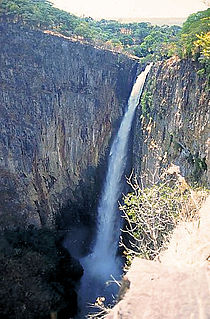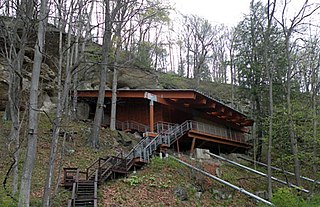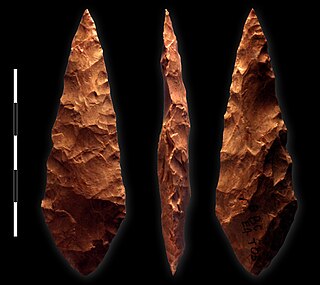
The Stone Age was a broad prehistoric period during which stone was widely used to make tools with an edge, a point, or a percussion surface. The period lasted for roughly 3.4 million years, and ended between 4,000 BCE and 2,000 BCE, with the advent of metalworking. Though some simple metalworking of malleable metals, particularly the use of gold and copper for purposes of ornamentation, was known in the Stone Age, it is the melting and smelting of copper that marks the end of the Stone Age. In Western Asia, this occurred by about 3,000 BCE, when bronze became widespread. The term Bronze Age is used to describe the period that followed the Stone Age, as well as to describe cultures that had developed techniques and technologies for working copper alloys into tools, supplanting stone in many uses.

Acheulean, from the French acheuléen after the type site of Saint-Acheul, is an archaeological industry of stone tool manufacture characterized by the distinctive oval and pear-shaped "hand axes" associated with Homo erectus and derived species such as Homo heidelbergensis.

Behavioral modernity is a suite of behavioral and cognitive traits that distinguishes current Homo sapiens from other anatomically modern humans, hominins, and primates. Most scholars agree that modern human behavior can be characterized by abstract thinking, planning depth, symbolic behavior, music and dance, exploitation of large game, and blade technology, among others. Underlying these behaviors and technological innovations are cognitive and cultural foundations that have been documented experimentally and ethnographically by evolutionary and cultural anthropologists. These human universal patterns include cumulative cultural adaptation, social norms, language, and extensive help and cooperation beyond close kin.

The Kalambo Falls on the Kalambo River is a 772-foot (235 m) single-drop waterfall on the border of Zambia and Rukwa Region, Tanzania at the southeast end of Lake Tanganyika. The falls are some of the tallest uninterrupted falls in Africa. Downstream of the falls is the Kalambo Gorge, which has a width of about 1 km and a depth of up to 300 m, running for about 5 km before opening out into the Lake Tanganyika rift valley. The Kalambo waterfall is the tallest waterfall in both Tanzania and Zambia. The expedition which mapped the falls and the area around it was in 1928 and led by Enid Gordon-Gallien. Initially it was assumed that the height of falls exceeded 300 m, but measurements in the 1920s gave a more modest result, above 200 m. Later measurements, in 1956, gave a result of 221 m. After this several more measurements have been made, each with slightly different results. The width of the falls is 3.6–18 m.
The Wilton culture is the name given by archaeologists to an archaeological culture which was common to parts of south and east Africa around six thousand years ago, during the Stone Age period. The culture is characterized by a greater number of tool types, distinguishing it from its predecessors.
The Sangoan is the name given by archaeologists to a Palaeolithic tool manufacturing style which may have developed from the earlier Acheulian types. In addition to the Acheulian stone tools, bone and antler picks were also used. Sangoan toolkits were used especially for grubbing.
The Magosian is the name given by archaeologists to an industry found in southern and eastern Africa. It dates to between 10,000 and 6,000 years BC and is distinguished from its predecessors by the use of microliths and small blades.

Africa has the longest record of human habitation in the world. The first hominins emerged 6-7 million years ago, and among the earliest anatomically modern human skulls found so far were discovered at Omo Kibish, Jebel Irhoud, and Florisbad.
Mbala is Zambia’s most northerly large town and seat of Mbala District, occupying a strategic location close to the border with Tanzania and controlling the southern approaches to Lake Tanganyika, 40 km by road to the north-west, where the port of Mpulungu is located. It had a population of about 20,000 in 2006. Under the name Abercorn, Mbala was a key outpost in British colonial control of this part of south-central Africa. It is headquarters of an administrative district of the Northern Province.

In the sequence of cultural stages first proposed for the archaeology of the Americas by Gordon Willey and Philip Phillips in 1958, the Lithic stage was the earliest period of human occupation in the Americas, as post-glacial hunter gatherers spread through the Americas. The stage derived its name from the first appearance of Lithic flaked stone tools. The term Paleo-Indian is an alternative, generally indicating much the same period.

John Desmond Clark was a British archaeologist noted particularly for his work on prehistoric Africa.

Meadowcroft Rockshelter is an archaeological site located near Avella in Jefferson Township, Washington County, Pennsylvania, United States. The site is a rock shelter in a bluff overlooking Cross Creek, and contains evidence that the area may have been continually inhabited for more than 19,000 years. If accurately dated, it would be one of the earliest known sites with evidence of a human presence and continuous human occupation in the New World.

The Albertine Rift is the western branch of the East African Rift, covering parts of Uganda, the Democratic Republic of the Congo (DRC), Rwanda, Burundi and Tanzania. It extends from the northern end of Lake Albert to the southern end of Lake Tanganyika. The geographical term includes the valley and the surrounding mountains.

The Middle Stone Age was a period of African prehistory between the Early Stone Age and the Late Stone Age. It is generally considered to have begun around 280,000 years ago and ended around 50–25,000 years ago. The beginnings of particular MSA stone tools have their origins as far back as 550–500,000 years ago and as such some researchers consider this to be the beginnings of the MSA. The MSA is often mistakenly understood to be synonymous with the Middle Paleolithic of Europe, especially due to their roughly contemporaneous time span, however, the Middle Paleolithic of Europe represents an entirely different hominin population, Homo neanderthalensis, than the MSA of Africa, which did not have Neanderthal populations. Additionally, current archaeological research in Africa has yielded much evidence to suggest that modern human behavior and cognition was beginning to develop much earlier in Africa during the MSA than it was in Europe during the Middle Paleolithic. The MSA is associated with both anatomically modern humans as well as archaic Homo sapiens, sometimes referred to as Homo helmei. Early physical evidence comes from the Gademotta Formation in Ethiopia, the Kapthurin Formation in Kenya and Kathu Pan in South Africa.

The Livingstone Museum, formerly the David Livingstone Memorial Museum and after that, the Rhodes-Livingstone Museum, is the largest and the oldest museum in Zambia, located in Livingstone near Victoria Falls. The museum has exhibits of artifacts related to local history and prehistory, including photographs and musical instruments, and also holds possessions and memorabilia - including letters and journals - of David Livingstone, the explorer and missionary.
The Jurgens Site is a Paleo-Indian site located near Greeley in Weld County, Colorado. While the site was used primarily to hunt and butcher bison antiquus, there is evidence that the Paleo-Indians also gathered plants and seeds for food about 7,000 to 7,500 BC.
Buur Heybe, which translates to "The Hill of the Potter's Sand", is a late Pleistocene and Holocene archaeological complex located in the largest granite inselberg in the inter-riverine region of the southern Bay province of Somalia approximately 180 km northwest of the capital Mogadishu. Buur Heybe has a longstanding history of archaeological research dating back to the 1930s when Paolo Graziosi carried out the first professional archaeological excavation in Somalia in the rockshelter site of Gogoshiis Qabe in Buur Heybe. Further excavations by J. Desmond Clark in the 1950s and later by the Buur Ecological and Archaeological Project (BEAP) led by Steven Brandt in the 1980s have made Buur Heybe one of the best dated and closely studied archaeological sites in Somalia.

Enid Gordon-Gallien, was a British adventurer and pilot who was awarded the Back Award in 1930 for her expedition in Tanganyika.

Kathy Diane Schick is an American archaeologist and paleoanthropologist. She is Professor emeritus in the Cognitive Science Program at Indiana University and is a founder and co-director of the Stone Age Institute. Schick is most well known for her experimental work in taphonomy as well as her experimental work, with Nicholas Toth, on the stone tool technology of Early Stone Age hominins, including their work with the bonobo Kanzi who they taught to make and use simple stone tools similar to those made by our Early Stone Age ancestors.

The Kalambo Falls Prehistoric Sites is an archaeological site in Kapele ward in Kalambo District inside Rukwa Region of Tanzania. Professor John Desmond Clark explored the site from 1956 to 1959. Excavations in the lakebeds uncovered a stone age sequence from the early stone age to the iron age, with the majority of it stratified in residential floors.













